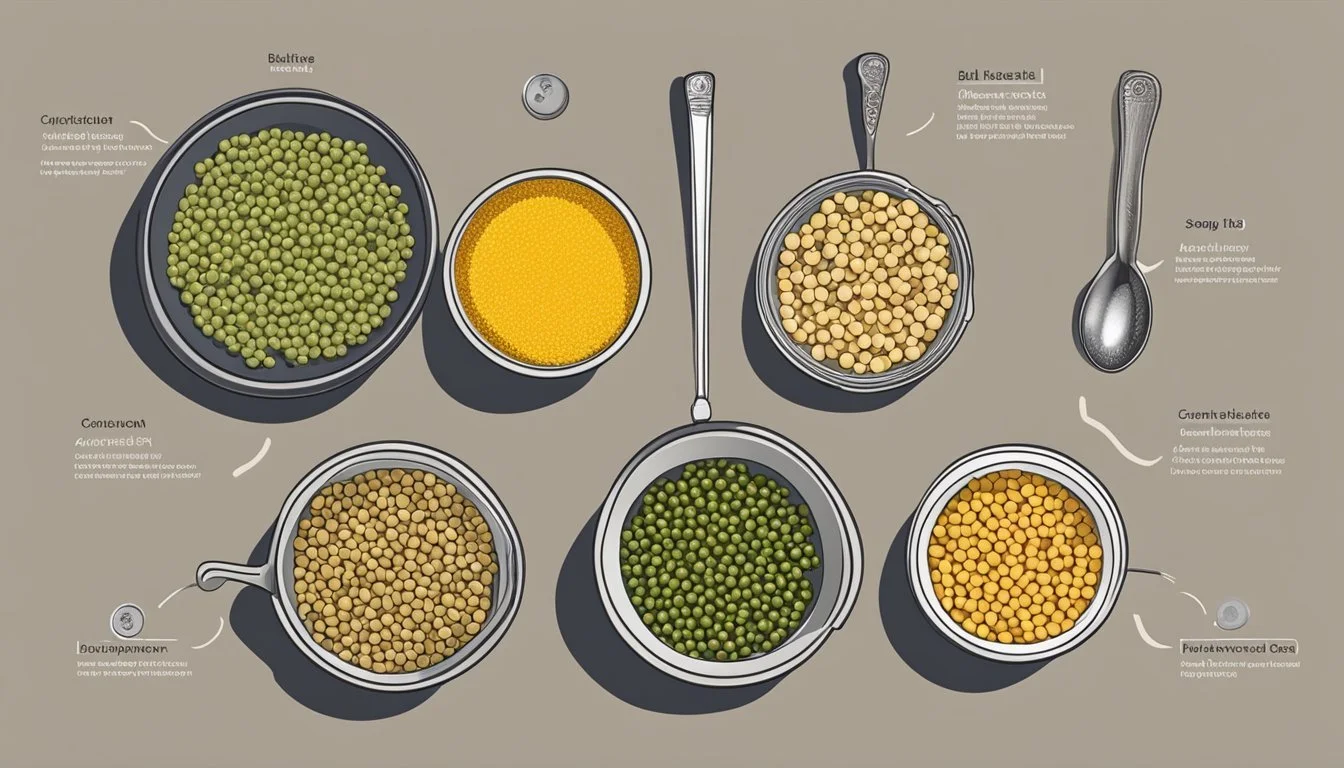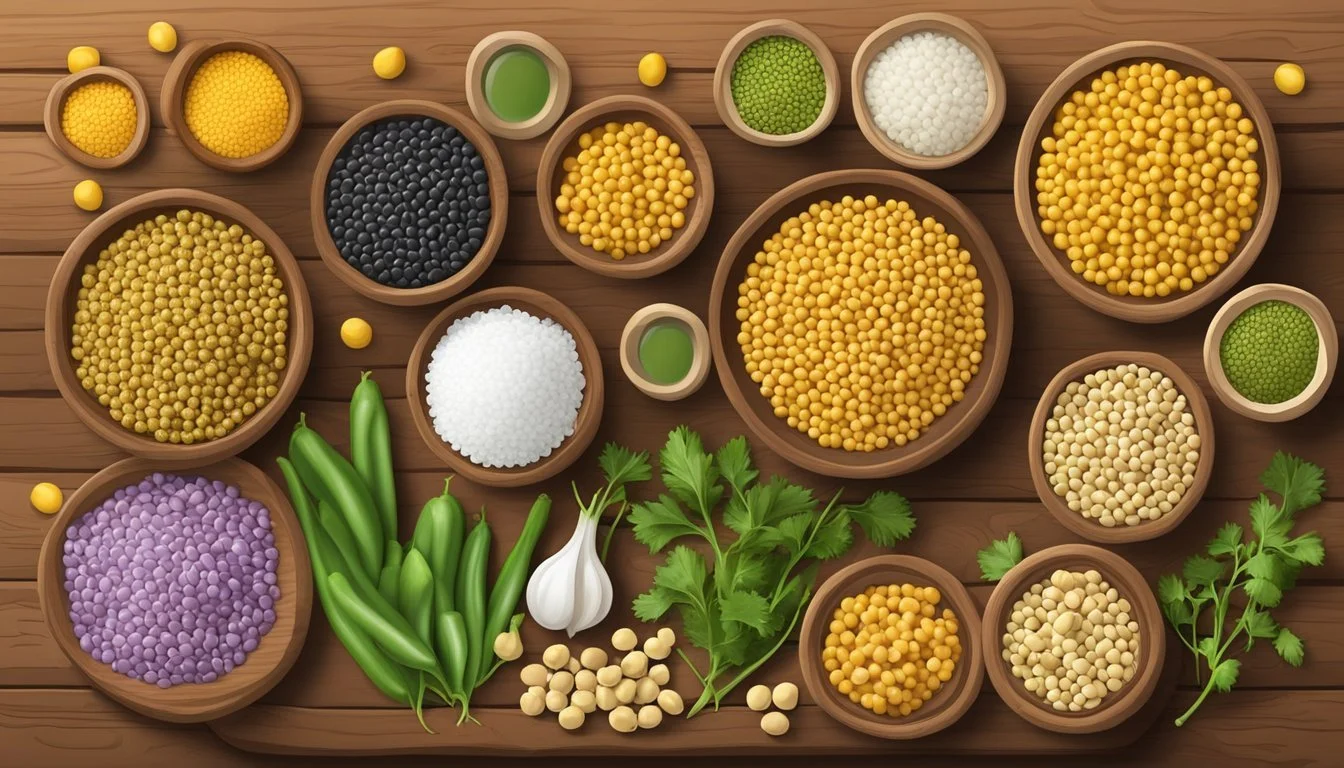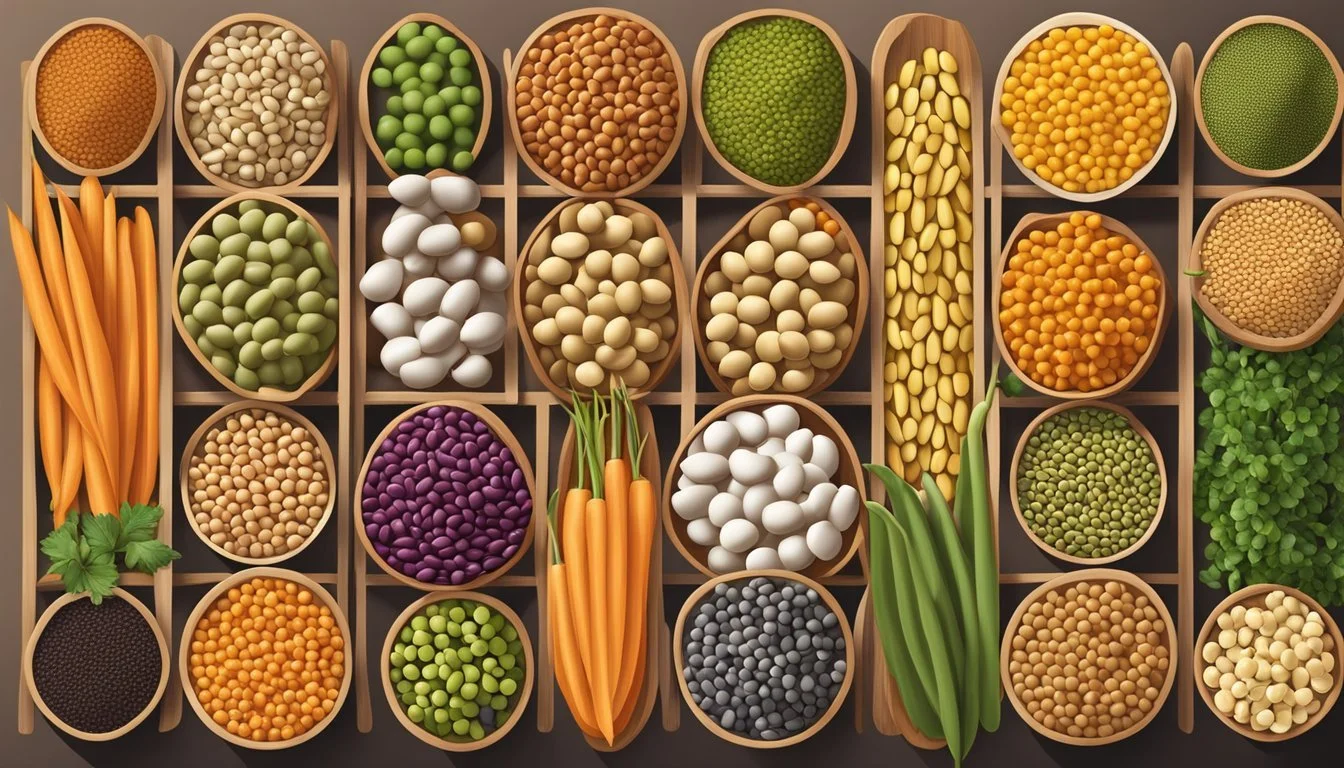Toor Dal Substitutes
Best Alternatives for Your Recipes
Finding the perfect substitute for toor dal can enhance your culinary creations without compromising taste or nutrition. Chana dal, Red lentils, Urad dal, Moong dal, and Split peas can serve as excellent alternatives. These legumes are not only staples in Indian cuisine but also provide a rich source of protein and fiber, making your dishes nutritious and delicious.
For those seeking a quick substitute, Split peas and Red lentils cook faster, making them ideal for time-sensitive recipes. Each substitute offers unique textures and flavors that can transform your meals while keeping them authentic to traditional Indian dishes.
Discover how these versatile ingredients can seamlessly replace toor dal and bring new dimensions to your cooking. Explore the world of legumes and make every dish count, whether it's a comforting dal or a scrumptious curry.
Understanding Toor Dal
Toor dal, also known as arhar dal or pigeon peas, is a staple in South Asian cuisine. Notably packed with protein and essential minerals, it's a key ingredient in dishes like sambar and dal makhani.
Nutritional Profile
Toor dal is a powerhouse of nutrition. A 50g serving provides about 11-12g of protein, making it an excellent source for vegetarians. It's also rich in fiber, iron, potassium, and magnesium, promoting overall health.
Nutrient Amount per 50g Protein 11-12g Fiber High Iron Moderate Potassium Significant Magnesium Considerable
The fiber content aids digestion, while iron supports blood health. Potassium and magnesium help in maintaining heart and muscle function. Additionally, trace amounts of calcium contribute to bone health.
Culinary Use in Indian Cuisine
In Indian cuisine, toor dal is ubiquitous. It forms the base of many curries and soups. For instance, sambar, a tangy and spicy South Indian dish, relies heavily on toor dal for its texture and flavor.
Popular recipes include dal makhani, where toor dal is slow-cooked with spices. It's also a key ingredient in khichdi, a comfort food made with rice and lentils. Toor dal is versatile and can be tailored to suit various palates.
Whether mashed to a creamy consistency or left slightly chunky, it blends well with assorted spices, making it indispensable in South Asian culinary traditions.
Finding the Right Substitute
When Toor dal is not available, selecting an appropriate substitute involves considering several key factors including flavor, texture, and nutritional content. Some ingredients closely mimic the original, making them excellent alternatives in various traditional Indian recipes.
Criteria for Substitution
The main criteria for substituting Toor dal are flavor, texture, and cooking time. Toor dal has a mild, slightly nutty flavor and a creamy texture when cooked.
A good substitute should match these characteristics as closely as possible. Additionally, they should have a similar nutritional profile, rich in protein and fiber. Cooking time is also crucial since some substitutes might require longer or shorter durations to achieve the desired consistency.
Suitable Substitutes Overview
Yellow Split Peas: These peas are often used in lieu of Toor dal due to their similar flavor and creamy texture. They are high in protein and fiber, making them a nutritious option.
Masoor Dal (Red Lentils): Red lentils cook quickly and offer a slightly nutty flavor. They are versatile in a range of dishes but might not hold their shape as well.
Chana Dal: Also known as split chickpeas, Chana Dal has a mild flavor and firm texture, ideal for soups and stews.
Urad Dal: Known for its nutty flavor and creamy texture, it works well in dishes like dosa or idli.
Moong Dal: These small, yellow lentils cook into a delightful soft texture, suiting various soups and stews.
Substitutes in Traditional Indian Dishes
Toor dal is a staple in many Indian dishes like Sambar, Dal Makhani, and various curries. Here's how to adapt these recipes:
Sambar: Use Yellow Split Peas or Masoor Dal. They blend well with tamarind and spices, offering a similar taste.
Dal Makhani: Urad Dal or Chana Dal makes a good substitute, providing the rich, creamy texture needed for this dish.
Dosa and Idli: Replace Toor dal with Urad Dal combined with rice flour. This combination ensures the batter ferments well and delivers the right consistency.
Rice Pudding (Kheer): Replace with Moong Dal to maintain the creamy, rich texture of this dessert.
The choice of substitute will depend on the specific dish and desired qualities, ensuring that flavors and textures are maintained or enhanced.
Preparing the Substitutes
When preparing substitutes for Toor dal, it is essential to consider the cooking techniques and the specific spices and condiments that can enhance the flavor of these alternatives.
Cooking Techniques and Times
Moong Dal: Moong dal cooks quickly and typically does not require extended soaking. Cooking it in an Instant Pot for about 10-12 minutes with natural pressure release is efficient. On the stovetop, it simmers to perfection in 20-25 minutes.
Urad Dal: Urad dal requires soaking for at least 30 minutes to an hour. It can then be cooked similarly to Toor dal in an Instant Pot for around 15 minutes or simmered on the stovetop for 30-40 minutes.
Lentils: Lentils, especially red lentils, cook much faster than Toor dal. No soaking is necessary. Stovetop cooking takes 15-20 minutes, or 5 minutes in an Instant Pot.
Split Yellow Peas: These can be used without soaking but benefit from a brief soak of about 30 minutes. Cooking time on the stovetop is around 45 minutes, while an Instant Pot cuts this down to about 15 minutes.
Spices and Condiments for Flavor Enhancement
Cumin Seeds: Fry cumin seeds in hot oil before adding the substitute dal to bring a warm, earthy flavor.
Garlic and Onion: Sauté minced garlic and chopped onions until golden brown to create a base that enhances the dish’s taste.
Coriander and Cilantro: Ground coriander adds a citrusy note, while fresh cilantro leaves can be used as a garnish.
Spices: Use spices like turmeric, ginger, bay leaves, and red chili powder to emulate the rich flavors of traditional Toor dal recipes.
Tomatoes: Adding diced tomatoes can provide a tangy depth to the dal substitute, ensuring a balanced flavor profile.
Salt and Cooking Oil: Season generously with salt and use oil (like ghee or vegetable oil) to temper spices for an enriched flavor.
Other Enhancements: Fresh ginger gives a spicy note, and bay leaves impart a subtle hint of aroma. Adjust the quantity based on personal taste preferences.
Utilize these techniques and spices to ensure substitutes for Toor dal not only match but potentially enhance the original recipe’s flavor and texture.
Incorporating Substitutes into Meals
Incorporating substitutes for toor dal into meals can enhance their nutritional value and introduce different textures and flavors. Various substitutes are suitable for main courses, side dishes, salads, savory snacks, and light eats.
Main Courses and Side Dishes
Substituting toor dal with split peas or black-eyed peas in curries, stews, and soups can be quite effective. Split peas provide a similar creamy texture and mild flavor, making them ideal in traditional dals and curry recipes. Black-eyed peas add a slightly nutty flavor and are excellent in vegetarian stews.
Mung beans are another versatile substitute. In dals, they offer a smooth, creamy texture when cooked. They can blend seamlessly with spices, enhancing curries and making a delicious side dish when paired with naan or rice.
Salads and Savory Snacks
For a nutritious twist in salads, yellow split peas and peanuts can replace toor dal. Yellow split peas, with their earthy flavor, mix well with fresh vegetables, nuts, and light dressings.
Adding black-eyed peas to salads not only boosts protein content but also introduces a slight nuttiness. For savory snacks, incorporating semolina in dishes like idli or dosa can provide the desired texture and taste, while maintaining the essence of traditional flavors.
Cashews can also be used in tempering, providing a rich, creamy contrast to dishes.
Breakfast and Light Eats
For breakfast recipes like idli and dosa, substituting urad dal with semolina can yield great results. Semolina offers a coarsely textured base that blends well with rice flour. This substitute is particularly useful in making Rava dosa, a popular breakfast dish.
Mung beans can be used in kheers or savory pancakes, providing a nutritious start to the day. Lastly, black-eyed peas are great in light eats such as chaat or small savory bites mixed with chutney for added flavor.
By integrating these substitutes thoughtfully, one can maintain the authentic taste and nutritional value of various Indian dishes.
Health and Dietary Considerations
When choosing substitutes for toor dal, it's essential to consider their nutritional content and dietary compatibility. Key factors include protein and fiber content and the suitability for vegan and gluten-free diets.
Protein and Fiber Content in Substitutes
Substitutes like red lentils, chickpeas, and mung beans are high in protein, making them excellent replacements. For example, red lentils provide about 18 grams of protein and roughly 8 grams of fiber per 100 grams.
These legumes are rich in dietary fiber, which aids digestion and helps maintain bowel health. Chickpeas, for instance, contain approximately 19 grams of protein and 7 grams of fiber per 100 grams, while mung beans offer around 24 grams of protein and 8 grams of fiber per 100 grams.
Given their high nutritional value, these substitutes also supply important minerals such as iron, potassium, calcium, and magnesium. This makes them beneficial not only for protein intake but also for overall nutritional balance.
Nutritional Comparison Table:
Substitute Protein (per 100g) Fiber (per 100g) Red Lentils 18g 8g Chickpeas 19g 7g Mung Beans 24g 8g
Vegan and Gluten-Free Options
For those following vegan or gluten-free diets, substitutes like quinoa, buckwheat, and amaranth are excellent choices. These grains are naturally gluten-free and provide important nutrients while being suitable for various dietary restrictions.
Quinoa is particularly valued for its complete protein profile, offering all nine essential amino acids. It provides around 14 grams of protein per 100 grams and is high in dietary fiber. Buckwheat, another gluten-free option, offers about 13 grams of protein and substantial fiber content.
Amaranth is a nutrient-dense pseudo-grain containing approximately 14 grams of protein and 6 grams of fiber per 100 grams. It is rich in minerals like iron, calcium, and magnesium, making it a robust option for those with specific dietary needs.
By exploring these options, individuals can find suitable substitutes that meet their nutrition and dietary preferences effectively.
Preservation and Storage of Substitutes
Proper preservation and storage of toor dal substitutes are essential to maintain their freshness and ensure their flavors remain intact. Implementing correct storage techniques and maximizing the freshness of these ingredients can significantly enhance your cooking experience.
Proper Storage Techniques
When storing substitutes like split peas or chickpeas, it is important to use airtight containers. This helps in protecting them from moisture, pests, and oxidation. Store dried legumes such as split peas, chickpeas, or black-eyed peas in a cool, dark place. A pantry or cupboard away from direct sunlight is ideal. Properly stored, these can last up to 12 months.
For semolina, keep it in an airtight container and place it in the refrigerator or a cool pantry. Given its susceptibility to spoilage due to moisture, refrigerated storage can extend its shelf life. If purchasing in bulk, consider dividing larger quantities into smaller portions to maintain freshness.
Maximizing Freshness and Flavor
Maximizing the freshness and flavor of substitutes ensures the best culinary results. For dried legumes, inspect them occasionally for signs of pests or spoilage. Rinse them thoroughly before cooking to remove any dust or debris accumulated during storage.
If you plan to store larger quantities of substitutes for extended timeframes, vacuum sealing can be a worthwhile investment. Vacuum-sealed packages keep out air and moisture, significantly preserving the flavor and extending shelf life.
For storing semolina, keep the container sealed tightly after each use to prevent exposure to humidity. Label containers with purchase dates to monitor freshness. Using freezer-safe containers for long-term storage can also help maintain quality and flavor over several months.
By following these storage guidelines, you can ensure that your substitutes stay fresh, flavorful, and ready to use whenever needed.
Conclusion
For those seeking substitutes for toor dal, there are several viable options. Split yellow peas, also known as toor dal, are a popular choice in Indian dishes. They offer a mild flavor and creamy texture, making them an excellent alternative.
Green split peas can also serve as a replacement. They provide added nutritional value with high protein and fiber content while mimicking the flavor profile of toor dal.
When preparing various recipes, black-eyed peas are another great option. They are versatile and can be used in many traditional dishes requiring toor dal.
Similarly, chickpeas can be utilized as a nutrient-rich substitute. Their firm texture and nutty taste pair well in soups and stews.
Additionally, lentils such as masoor dal can be easily integrated into your cooking. They offer a slightly sweet flavor that complements numerous recipes.
Here are some common substitutes for toor dal and their benefits:
Substitute Benefits Split Yellow Peas High in protein and fiber, mild flavor Green Split Peas Nutritional boost, similar taste Black-Eyed Peas Versatile, suitable for various dishes Chickpeas Firm texture, nutty flavor Masoor Dal Slightly sweet flavor, easy to use
Each substitute brings unique nutritional and taste characteristics that can enhance your recipes. Each of these alternatives can serve as reliable replacements for toor dal in various culinary applications.








